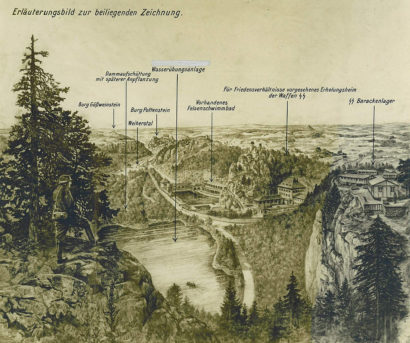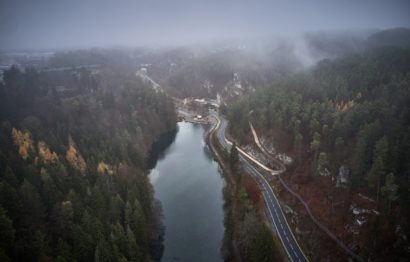Pottenstein Subcamp
October 12, 1942 – April 16, 1945
![]()
Postcard with buildings and facilities of the SS-Karstwehr in Pottenstein, without date (Bundesarchiv Berlin)
![]()
Aerial view of the work area near Pottenstein, 2018 (Flossenbürg Concentration Camp Memorial / Photo: Rainer Viertlböck)
![]()
The "Mager Barn" (Mager-Scheune) in Pottenstein, 2018 (Flossenbürg Concentration Camp Memorial / Photo: Rainer Viertlböck). The prisoners of the subcamp Pottenstein were quartered here.
-
Prisoners
At first 40, then 80 prisoners (December 1942), 180 (June 1943), and 359 (March 1945). In total 700 prisoners from Pottenstein, with the majority being Polish and Soviet prisoners. In addition to numerous German and Czcech men, there were also men from 8 other countries, including some Jews.
-
Many of the prisoners were skilled construction workers, due to frequent transfers there was a high rate of fluctuation.
-
Forced labor and quarters
The prisoners were forced to perform construction work, mainly for the SS Karstwehr, a specialist unit active in caves and gorges during the war. They built roads, dug a small reservoir for an aquatic training facility, and developed the Teufelshöhle, a nearby cave system.
-
Later, the prisoners were deployed to clear debris in Nuremberg after the air raids. At first the men were quartered in a youth hostel in Mariental, but from February 1943 they were in a barn of the brewery owner, Mager, in Pottenstein.
-
Guards
Flossenbürg SS-Men. Detail leader Wenzel Wodak was executed after the war for numerous murders.
-
Death toll
In Pottenstein itself, nine men died. A further 37 prisoners who were transferred back to Flossenbürg died within a month of their return.
-
Disbanding of the camp / end of the war
On April 16, 1945, the prisoners were liberated near Pottenstein, from which they had left the day before.
-
Commemoration
A commemorative plaque at the Pottenstein Cemetery memorializes the prisoners of the subcamp. The Dr. -Hans-Brand-Ring was renamed in 2001 because it honored the speleologist and SS Group Leader Hans Brand, the initiator of the subcamp.


